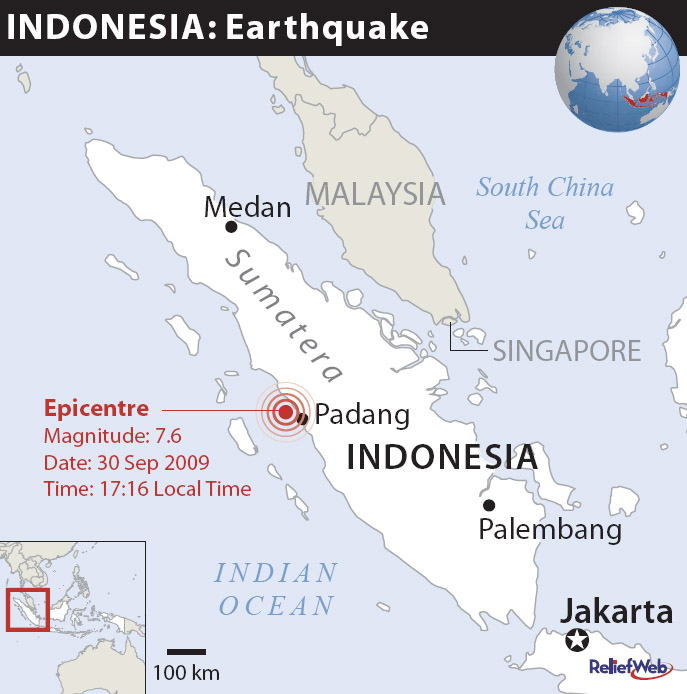At least 467 people have been killed in the quakes that devastated the provincial capital, Padang, and the nearby coastal town of Pariaman, according to Indonesia's Social Affairs Ministry.
“The death toll is likely to increase as many people are still trapped under collapsed buildings, homes and hotels,” Priyadi Kardono, a spokesman for the National Agency for Disaster Management, told IRIN.
A 7.9 magnitude quake struck off the coast of West Sumatra Province in the late afternoon on 30 September, swiftly followed by a 6.2 magnitude quake, according to the UN Office for the Coordination of Humanitarian Affairs (OCHA).
The earthquake occurred along the same fault-line that spawned the Indian Ocean tsunami in 2004, and was also felt in North Sumatra, Riau and Aceh in Indonesia, as well as Malaysia and Singapore.
OCHA said thousands of people were reported to be displaced after heavy rains and landslides, which followed the quakes, with reports of significant damage to infrastructure, including telecommunications, roads, bridges and water supply systems.
Air Putih, a local NGO, estimated that about 40 percent of buildings in Pariaman were heavily damaged, while television footage from Padang showed buildings in the city's business district in ruins.
Rescuers were shown struggling to remove debris from buildings where scores of people were believed trapped. Rains and crowds blocking the roads were hampering rescue efforts, TV One, a local TV station, reported.
|
Reuters video short on |
At the same time two Hercules C-130 military cargo aircraft left Jakarta carrying doctors and relief supplies, including tents, medicines and food.
“This earthquake is huge. The extent of the damage is likely to be similar to the earthquake in Yogyakarta,” Bakrie said, referring to the 2006 quake that hit Yogyakarta province on the island of Java, killing 5,744 people.
Rustam Pakaya, head of the health ministry's crisis centre, said a medical team had been dispatched to Padang to set up field hospitals for survivors.
A team of UN agencies, including OCHA, the World Health Organization (WHO) and the UN Development Programme (UNDP) has also travelled to the affected areas in West Sumatra to assess the damage and emergency relief needs of the population.
Aid agencies step in
International humanitarian group World Vision said it would send staff on 1 October to assess the damage.
“It is critical that we get people into the quake zone as soon as possible to find out what has happened. If buildings have collapsed, then people are likely to be in urgent need of food, water and especially shelter,” Jimmy Nadapdap, World Vision Indonesia's Humanitarian and Emergency Affairs director, said in a statement.
"What typically happens is that people become terrified to go back to their homes, especially if damaged, as there will be numerous aftershocks. Securing alternative shelter will be critical," he said.
Save the Children said it was mobilizing staff to provide aid to children and families in Western Sumatra. The group is providing relief to survivors of a 7.0 magnitude earthquake that struck West Java province last month, killing 81 people and displacing about 200,000.
Indonesia, the world's largest archipelago, sits on the Pacific "Ring of Fire", the edge of a tectonic plate prone to seismic upheaval.
Experts said West Sumatra, especially Padang, is at risk of being devastated by a tsunami in the event of an earthquake similar in magnitude to the one that triggered the 2004 Indian Ocean tsunami, which killed more than 220,000 people across Asian and African countries.
atp/ey/ds/mw
This article was produced by IRIN News while it was part of the United Nations Office for the Coordination of Humanitarian Affairs. Please send queries on copyright or liability to the UN. For more information: https://shop.un.org/rights-permissions





